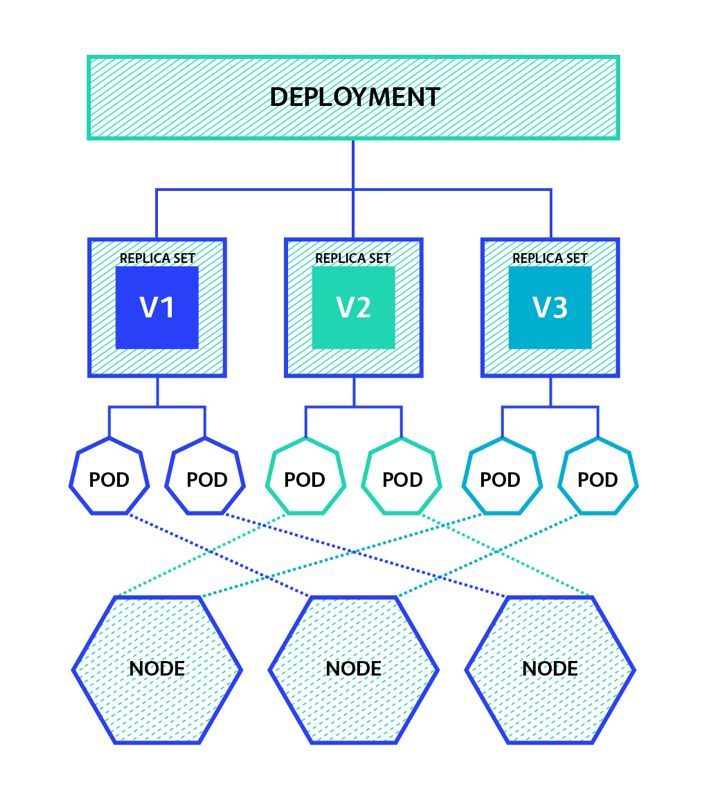Understanding 🚀the difference between Deployment and ReplicaSet ✅in Kubernetes
 Manish Syal
Manish Syal
Introduction:
Kubernetes is an open-source compartment arrangement stage that robotizes the sending, scaling, and boarding of containerized applications. Two important Kubernetes objects are deployment and replica set, which are used to manage pods, the smallest deployable units. Although they share some similarities, their features and application scenarios are fundamentally different.
In this blog post, we'll talk about the differences between Kubernetes deployment and replica set.
Small Intro to Deployment and ReplicaSet:
➼ In Kubernetes, deployment and replicaSet are two crucial components that aid in application lifecycle management and high availability.
➼ ReplicaSet ensures that a predetermined number of replica Pods are always running, while Deployment is in charge of managing the creation, scaling, and updating of ReplicaSets.
➼ By utilizing these parts, Kubernetes can without much of a stretch deal with the application lifecycle, guarantee adaptation to non-critical failure, and give consistent updates and rollbacks.
𝙳𝚒𝚏𝚏𝚎𝚛𝚎𝚗𝚌𝚎 𝚋𝚎𝚝𝚠𝚎𝚎𝚗 𝚛𝚎𝚙𝚕𝚒𝚌𝚊𝚜𝚎𝚝 & 𝙳𝚎𝚙𝚕𝚘𝚢𝚖𝚎𝚗𝚝?
𝗥𝗲𝗽𝗹𝗶𝗰𝗮𝗦𝗲𝘁:
① It is a simpler object and is responsible only for maintaining a specific number of replicas of a pod.
② It does not support rolling updates and rollbacks of application versions.
③ It is used for scaling a single type of Pod.
④ It's a lower-level resource than a Deployment and is mainly used by Deployments to manage replicas.
𝗗𝗲𝗽𝗹𝗼𝘆𝗺𝗲𝗻𝘁:
① It provides a way to manage the lifecycle of ReplicaSets and Pods.
② It supports rolling updates, rollbacks, and scaling of application replicas.
③ It is used for managing multiple ReplicaSets and scaling different types of Pods.
𝗥𝗼𝗹𝗹𝗼𝘂𝘁:
If there are problems in the deployment, Kubernetes will automatically roll-back to the previous version,
however we can also explicitly role-back to a specific revision
Example:
Rollout to the previous version(one version back):
➣ 𝘬𝘶𝘣𝘦𝘤𝘵𝘭 𝘳𝘰𝘭𝘭𝘰𝘶𝘵 𝘶𝘯𝘥𝘰 𝘥𝘦𝘱𝘭𝘰𝘺/𝘮𝘺𝘥𝘦𝘱𝘭𝘰𝘺𝘮𝘦𝘯𝘵
Rollout to a specific version:
➣ kubectl rollout undo deploy/mydeployment --to-revision=2
To check whether the deployment was created or not :
➣ kubectl get deploy
To check, how deployment creates Replicaset and pods:
➣ kubectl describe deploy mydeployment
To scale replica through the command:
➣ kubectl get rs (rs= replica set)
➣ kubectl scale --replicas=6 deploy mydeployment
To check how many versions you have created
➣ kubectl rollout history deployment{or deploy} mydeployment
For deleting Deployment: kubectl delete deployment mydeployment
𝘄𝗵𝗲𝗻 𝗼𝘂𝗿 𝗱𝗲𝗽𝗹𝗼𝘆𝗺𝗲𝗻𝘁 𝗰𝗼𝘂𝗹𝗱 𝗳𝗮𝗶𝗹𝗲𝗱 ?
1. Insufficient quota: the required resources are not allocated.
2. readiness prob failures: let's say a node is not ready while applying deployment
3. Image pull error: due to version, image not available etc.
4. Insufficient permission
5. Limit Ranges
6. Application runtime misconfiguration
𝗗𝗲𝗽𝗹𝗼𝘆𝗺𝗲𝗻𝘁 𝗳𝗶𝗹𝗲:
𝗗𝗲𝗽𝗹𝗼𝘆𝗺𝗲𝗻𝘁 𝗳𝗶𝗹𝗲:
𝙠𝙞𝙣𝙙: 𝘿𝙚𝙥𝙡𝙤𝙮𝙢𝙚𝙣𝙩
𝙖𝙥𝙞𝙑𝙚𝙧𝙨𝙞𝙤𝙣: 𝙖𝙥𝙥𝙨/𝙫1
𝙢𝙚𝙩𝙖𝙙𝙖𝙩𝙖:
𝙣𝙖𝙢𝙚: 𝙢𝙮𝙙𝙚𝙥𝙡𝙤𝙮𝙢𝙚𝙣𝙩𝙨
𝙨𝙥𝙚𝙘:
𝙧𝙚𝙥𝙡𝙞𝙘𝙖𝙨: 2
𝙨𝙚𝙡𝙚𝙘𝙩𝙤𝙧:
𝙢𝙖𝙩𝙘𝙝𝙇𝙖𝙗𝙚𝙡𝙨:
𝙣𝙖𝙢𝙚: 𝙙𝙚𝙥𝙡𝙤𝙮𝙢𝙚𝙣𝙩
𝙩𝙚𝙢𝙥𝙡𝙖𝙩𝙚:
𝙢𝙚𝙩𝙖𝙙𝙖𝙩𝙖:
𝙣𝙖𝙢𝙚: 𝙩𝙚𝙨𝙩𝙥𝙤𝙙
𝙡𝙖𝙗𝙚𝙡𝙨:
𝙣𝙖𝙢𝙚: 𝙙𝙚𝙥𝙡𝙤𝙮𝙢𝙚𝙣𝙩
𝙨𝙥𝙚𝙘:
𝙘𝙤𝙣𝙩𝙖𝙞𝙣𝙚𝙧𝙨:
- 𝙣𝙖𝙢𝙚: 𝙘00
𝙞𝙢𝙖𝙜𝙚: 𝙪𝙗𝙪𝙣𝙩𝙪
𝙘𝙤𝙢𝙢𝙖𝙣𝙙: ["/𝙗𝙞𝙣/𝙗𝙖𝙨𝙝", "-𝙘", "𝙬𝙝𝙞𝙡𝙚 𝙩𝙧𝙪𝙚; 𝙙𝙤 𝙚𝙘𝙝𝙤 𝘿𝙚𝙖𝙩𝙝-𝙉𝙤𝙩𝙚; 𝙨𝙡𝙚𝙚𝙥 5; 𝙙𝙤𝙣𝙚"]
Subscribe to my newsletter
Read articles from Manish Syal directly inside your inbox. Subscribe to the newsletter, and don't miss out.
Written by
